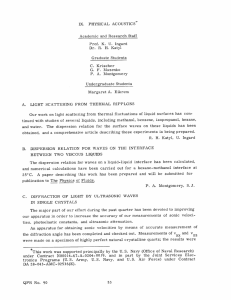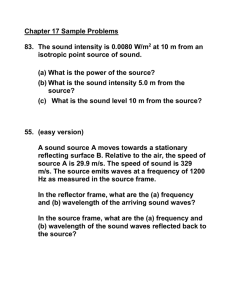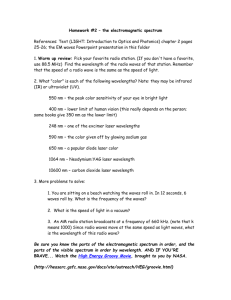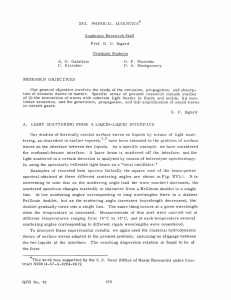XVIII. PHYSICAL ACOUSTICS* Academic and Research Staff
advertisement
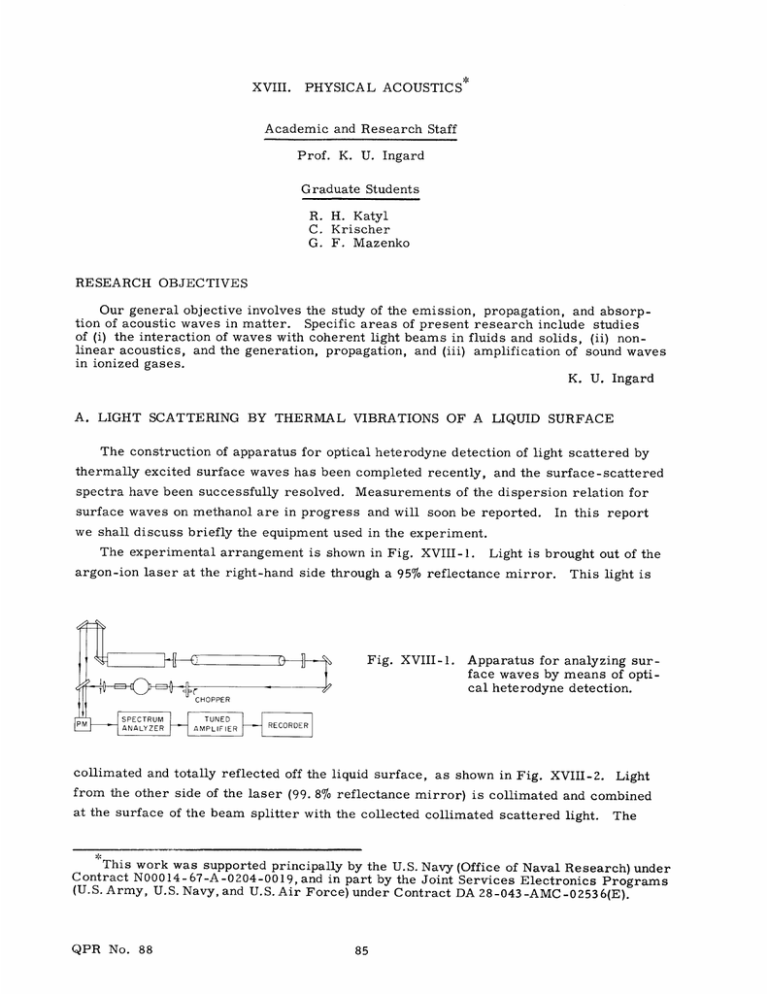
XVIII. PHYSICAL ACOUSTICS* Academic and Research Staff Prof. K. U. Ingard Graduate Students R. H. Katyl C. Krischer G. F. Mazenko RESEARCH OBJECTIVES Our general objective involves the study of the emission, propagation, and absorption of acoustic waves in matter. Specific areas of present research include studies of (i) the interaction of waves with coherent light beams in fluids and solids, (ii) nonlinear acoustics, and the generation, propagation, and (iii) amplification of sound waves in ionized gases. K. U. Ingard A. LIGHT SCATTERING BY THERMAL VIBRATIONS OF A LIQUID SURFACE The construction of apparatus for optical heterodyne detection of light scattered by thermally excited surface waves has been completed recently, and the surface-scattered spectra have been successfully resolved. Measurements of the dispersion relation for surface waves on methanol are in progress and will soon be reported. In this report we shall discuss briefly the equipment used in the experiment. The experimental arrangement is shown in Fig. XVIII-1. Light is brought out of the argon-ion laser at the right-hand side through a 95% reflectance mirror. This light is Fig. XVIII-1. S Apparatus for analyzing surface waves by means of optical heterodyne detection. CHOPPER PM SPECTRUM TUNED ANALYZER AMPLIFIER RECORDER RECORDER collimated and totally reflected off the liquid surface, as shown in Fig. XVIII-2. Light from the other side of the laser (99. 8% reflectance mirror) is collimated and combined at the surface of the beam splitter with the collected collimated scattered light. The This work was supported principally by the U.S. Navy (Office of Naval Research) under Contract N00014-67-A-0204-0019, and in part by the Joint Services Electronics Programs (U.S. Army, U.S. Navy, and U.S. Air Force) under Contract DA 28-043-AMC-02536(E). QPR No. 88 (XVIII. PHYSICAL ACOUSTICS) combined beams are placed on the surface of a photodetector, and the beat signal is amplified and spectrally resolved with an ultrasonic spectrum analyzer. To enhance the signal-to-noise ratio, the scattered light is chopped, the spectrum analyzer output is fed through a narrow-band (6-Hz) amplifier tuned to the chopper frequency, the output of which is detected and integrated. In this way, the beat signal is easily extracted from the shot noise produced by the local-oscillator signal. Because of the large Doppler width of the argon ion laser, the path lengths of scattered and local-oscillator light must be nearly equal for the individual beat signals produced by the many longitudinal modes of the laser to add in phase. This is accomplished by using three mirrors in the local-oscillator beam. LIQUID SURFACE RAYLEIGH HORN Fig. XVIII-2. SCATTERED BEAM TRANSDUCER a BUFFER ROD Close-up of scattering sample and optics. INCIDENT BEAM To facilitate the determination of the surface wavelength, a sinusoidal deformation of the surface of known wavelength is produced by a 50-MHz or 90-MHz ultrasonic wave reflected off the surface at a known angle. This wave is introduced with the buffer rod shown in Fig. XVIII-2. With the collecting optics aligned to the light beam diffracted by this surface deformation, the surface waves that are observed have a wavelength A/sin where A is the wavelength, and 0a the inclination angle of the applied ultrasonic field. Thus with this arrangement, the wavelength, oat frequency, and lifetime of surface waves can be accurately measured. It will now be possible to explore this hitherto unexplored wavelength region and check for any departures from the classical theory of surface waves. R. H. Katyl, U. Ingard B. PHOTOELASTIC AND ELASTIC PROPERTIES OF LaF 3 Our measurements of the photoelastic and elastic properties of LaF 3 continue. 1 3 with an argon-ion 4 laser and they concluded that the crystal possessed a unit cell of D 3 d symmetry (tri3 gonal). The deviations from the earlier proposed D 6 h (hexagonal) unit cell are relatively small, and result from a displacement of some of the fluorine ions by less than Recently, Bauman and Porto observed the Raman spectrum of LaF 0. 063 lattice units (0. 463 A). It will be interesting to try to verify the trigonal symmetry by the macroscopic QPR No. 88 (XVIII. acoustic propagation properties of the sample. PHYSICAL ACOUSTICS) For a hexagonal crystal, the x l -x 2 plane is acoustically isotropic; any wave vector k lying in that plane has three pure acoustic modes (ullk, ullx3 , u X x 3 ) whose phase velocity is independent of the azimuthal angle. For a trigonal crystal, the three acoustic waves corresponding to a wave vector k lying in the x 1 -x 2 plane are generally quasi-modes; furthermore, the phase velocity is dependent on the azimuthal angle. We have compared the phase velocities for two longitudinal waves propagating in the basal plane of our sample at azimuthal angles of approximately 13* and 1030, respectively. We could not detect any difference in veloc- ity, within 0. 5%. It is highly desirable to obtain a new LaF 3 sample in which the faces are oriented perpendicular to the three crystallographic axes within ±0. 5*, 20 seconds. and are parallel within We are doing some x-ray and optical analysis of several specimens, at present, in the hope of obtaining as perfect and large a crystal as possible. State-of-the-art elastic constant measurements are carried out, at present, to accuracies of tenths of a per cent by phase-comparison or pulse-superposition techniques.2 In both of these techniques, however, one obtains an average "over the mosaic structure" of the crystal. By measuring the angle through which a narrow beam of light is scattered by sound waves, itis possible to obtain a considerably more "local" value for the phase velocity. We are now refining our experimental apparatus so that we shall be able to compare velocities of sound as measured by pulse-superposition or Brillouin scattering within better than 0.5%. C. Krischer References 1. R. P. Bauman and S. P. S. Porto, "Lattice Vibrations and Structure of Rare-Earth Fluorides," Phys. Rev. 161, 842 (1967). 2. H. J. McSkimin, in Physical Acoustics, W. P. Mason (ed.) (Academic Press, Inc., New York, 1964), Vol. I-A, Chap. 4. C. NONLINEAR MODE COUPLING IN THE VIBRATING STRING A string driven to oscillate in a plane by an external force field is known to become unstable for small perturbations in the transverse direction at sufficiently large values of the driving force. As a result, instead of vibrating in a plane, the string will start to whirl. In an attempt to find a theoretical explanation for this behavior, Murthy and Ramakrishna, considering coupling between transverse modes of motion in the string, have made calculations, recently. In re-examining this question, however, we have found that the nonlinear equations of the string, correct to third order in the amplitude, must include not only coupling between the transverse modes of motion but also coupling QPR No. 88 (XVIII. PHYSICAL ACOUSTICS) between the longitudinal and transverse modes. Including this type of mode coupling, we find qualitatively the same kind of criterion as Murthy and Ramakrishna for the onset of whirling motion, but our numerical values involved in the criterion are somewhat different. The work, thus far, has been concerned only with the stability criterion, without regard to the time dependence during the growth of the whirling motion. Work is, at present, under way to extend the analysis to include the time dependence of the instability. G. Mazenko, U. Ingard References 1. G. S. S. Murthy and B. S. Ramakrishna, J. Acoust. Soc. Am. 38, 461-471 (1965). QPR No. 88
